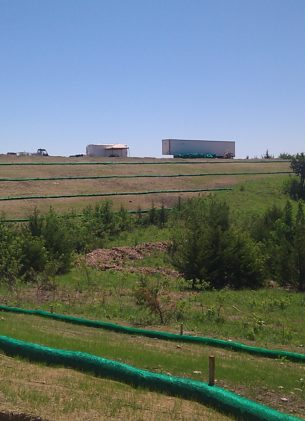News
Turning a Waste Source into a Resource
By Shannon Lux, Sustainable Environmental Consultants Operations Manager and Greg Williams, WTS Regional Manager
After a vegetation management service trims a tree, the trimmings can either be recycled or dumped in a landfill. There are various ways that wood chips can be given a second life. WTS donates wood chips for use in communities throughout the country, such as parks, trails or zoos, who use chips as animal bedding. When requested, WTS also gives wood chips to homeowners.
However, organic landscaping is not the only option to salvage tree trimmings. A more environmentally sustainable way to recycle wood chips is by manufacturing Filtrexx® SiltSoxx™. WTS and Sustainable Environmental Consultants (SEC) partnered together to create a path for tree trimmings to be reused as SiltSoxx, an erosion control device, diverting organic matter from landfills which reduces those greenhouse gas emissions from being related into the atmosphere.
What is SiltSoxx and why does it matter?
SiltSoxx is generated from a tubular nylon casing containing wood chips used to filter water runoff and control erosion on construction sites and other disturbed areas. It’s used in locations where vegetation is ultimately going to be established. The wood chips in the SiltSoxx have the ability to chemically bind some of the invisible contaminants in water and slow the runoff to minimize soil disturbance as vegetation grows.
Maintaining water and soil integrity around construction sites has far-reaching impact on the environment. Construction sites have compliance regulations to minimize the environmental disturbance of projects and fines can be issued if sites are not maintained properly. Sedimentation of waterways is a large environmental concern due to its impact on water quality and aquatic life locally and downstream.
For example, the Gulf of Mexico’s hypoxic zone is a result of sedimentation and nutrient pollution from upstream urban and rural point and nonpoint source pollution.
Although there are other erosion control products, SiltSoxx is the most environmentally sustainable option that outperforms all other devices, like silt fence, in keeping more sediment and contaminants from entering our water bodies. Silt fence is a petroleum-based plastic product instead of being generated from a majority of repurposed organic matter like SiltSoxx, is the complete opposite – It is an additional pollutant that ends its life in a landfill. According to a 2017 EPA report, almost 20% of landfill volume resulted from plastics, a figure that has been increasing greatly over the last few decades. One mile of silt fence is equivalent to generating 8,244 tons of CO2 equivalent in its lifetime, whereas one mile of 12- inch SiltSoxx with filter media prevents 369 tons of CO2 equivalent.
SEC became a certified manufacturer of SiltSoxx in 2009. From 2016 to present day, SEC has manufactured about 26,000 cubic yards or 8,826 pallets of SiltSoxx, and their yearly average has steadily increased over the past 5 years. That is over 6,500 tons of organic matter or 1,733 chipper trucks full. WTS has established a goal to continue to repurpose organic matter waste. They’ve concentrated their efforts in areas where there are not opportunities to donate wood chips for organic landscaping, thus reducing the waste going to landfills. Both companies hope to continue growing this partnership for a sustainable future.
Currently, WTS is doing land excavation for rights-of-way (ROW) in the Midwest. As crews pull out trees and prepare the way for utility poles, soil is loosened up. During this process, SiltSoxx are being installed along creek banks, waterways and anywhere poles may be set or there is major soil disturbance. In some cases, the SiltSoxx installed for ROW construction contain wood chips cut from the utility’s existing ROW.
How is a SiltSoxx made?
As part of the partnership between WTS and SEC, WTS chips the wood trimmed from trees on ROW to be the correct size for SiltSoxx. They then dump the chips at one of SEC’s SiltSoxx manufacturing sites, located in Topeka, Kansas, and Austin, Texas. The majority of the wood chips reused in SEC’s SiltSoxx come from trees WTS trims on ROW in a 25-30-mile radius around the manufacturing site.
SEC inspects the chips to ensure they meet specifications and removes vines and larger materials. Once the wood chips are approved, they are placed into the SiltSoxx material. SEC manufactures three different sizes of SiltSoxx; 8”x160’, 12”x100’ and 18”x50’. Once completed, they are placed on pallets to be shipped to the designated location for onsite install.
SiltSoxx has a 2- to 5-year life span depending on site conditions and rain events. Once the site is stabilized, which is typically when 70% of vegetation is established, the contractor can cut the SiltSoxx open and spread the chips around the site to add organic matter to the soil. The remaining SiltSoxx material can then be disposed of. SiltSoxx creates less material to dispose of at the end of a project than other erosion control materials, such as silt fence, straw waddles or excelsior logs.
In order for SEC to remain a Filtrexx certified manufacturer, they are annually required to submit a wood chip sample from each manufacturing location to Filtrexx, which tests for the following requirements:
- PH level is between 5.0 and 8.0
- Less than 60% moisture content
- 99% of particle sizes pass through a 2” sieve and a maximum of 60% pass through a 3/8” sieve
- Inert or foreign man-made material is less than 1% by dry weight
The wood chips are also tested for any harmful pollutants, like fecal coliform.
Pursuing the environmentally responsible ways of reusing and recycling brush, rather than just dumping brush in landfills, helps offset some of the pollution created by using vegetation management equipment, leading towards a smaller carbon footprint. Using SiltSoxx on construction sites, near waterways and around utility poles is one of the many ways the vegetation management industry can positively impact the environment.
If you’re interested in learning more about SiltSoxx, visit sustainableenviro.com.
References
Cho, Renee. “What Happens to All That Plastic?” State of the Planet, 3 June 2019, blogs.ei.columbia.edu/2012/01/31/what-happens-to-all-that-plastic
LeBlanc, Rick. “Polypropylene Recycling – An Introduction.” The Balance Small Business, www.thebalancesmb.com/an-overview-of-polypropylene-recycling-2877863


